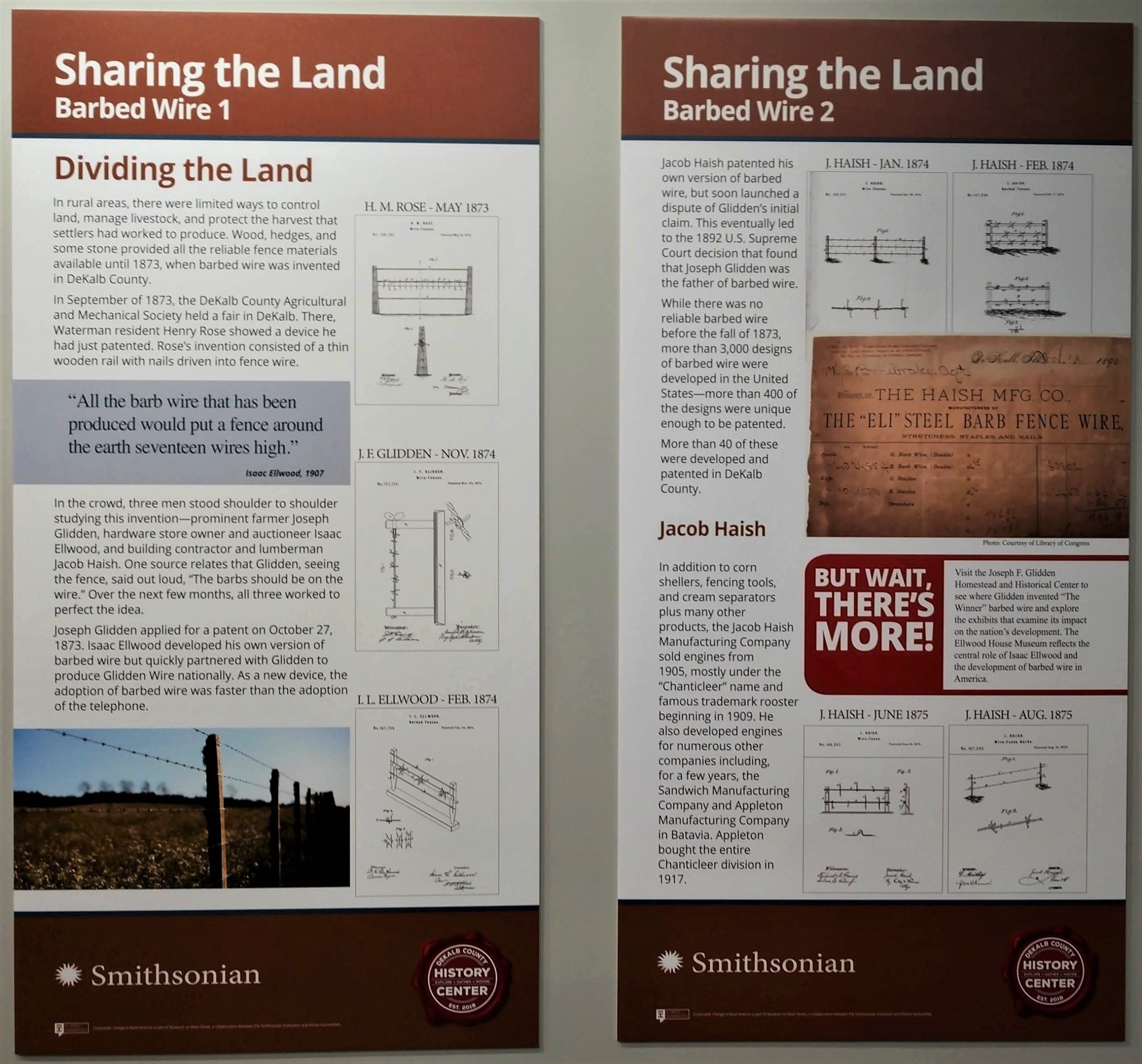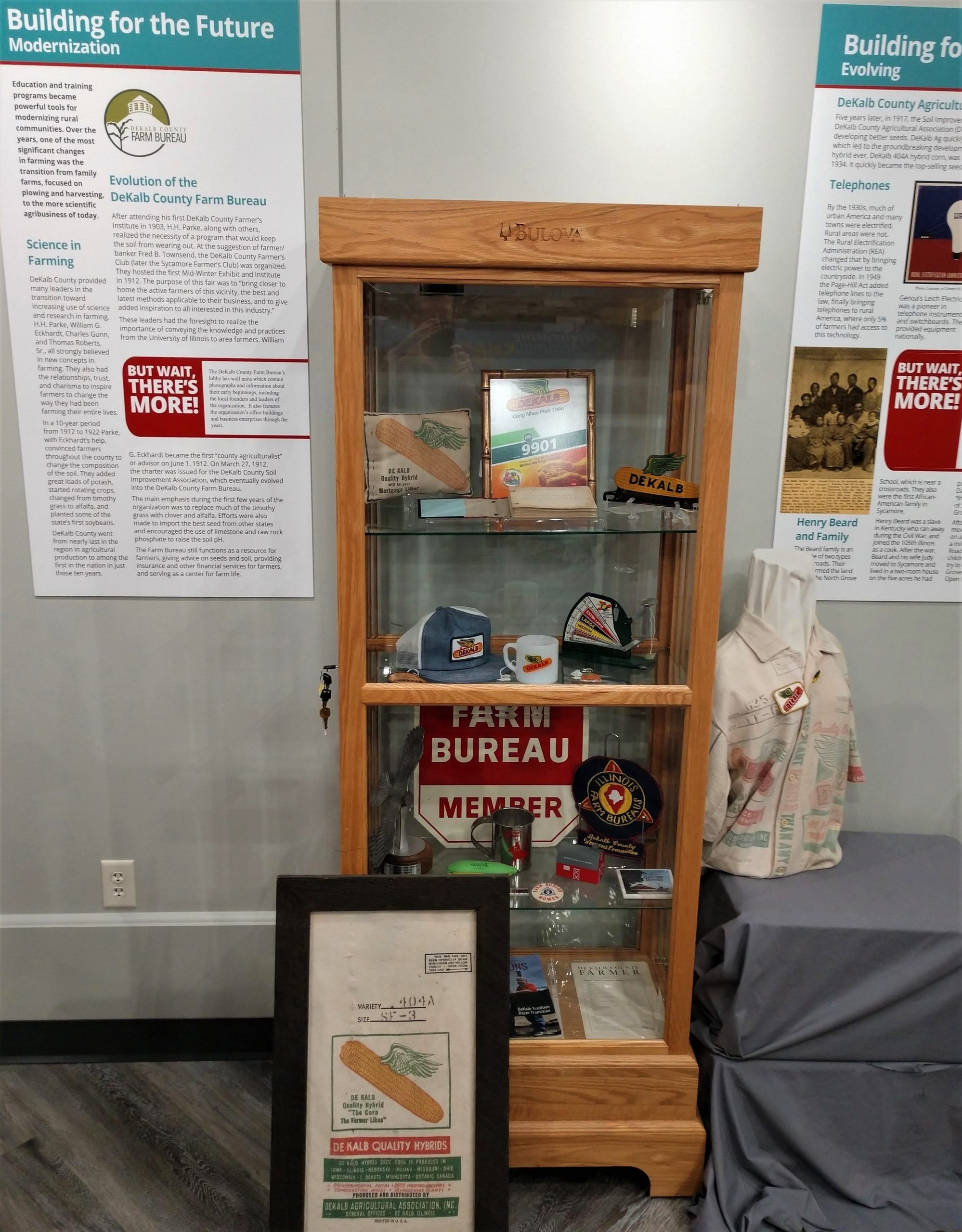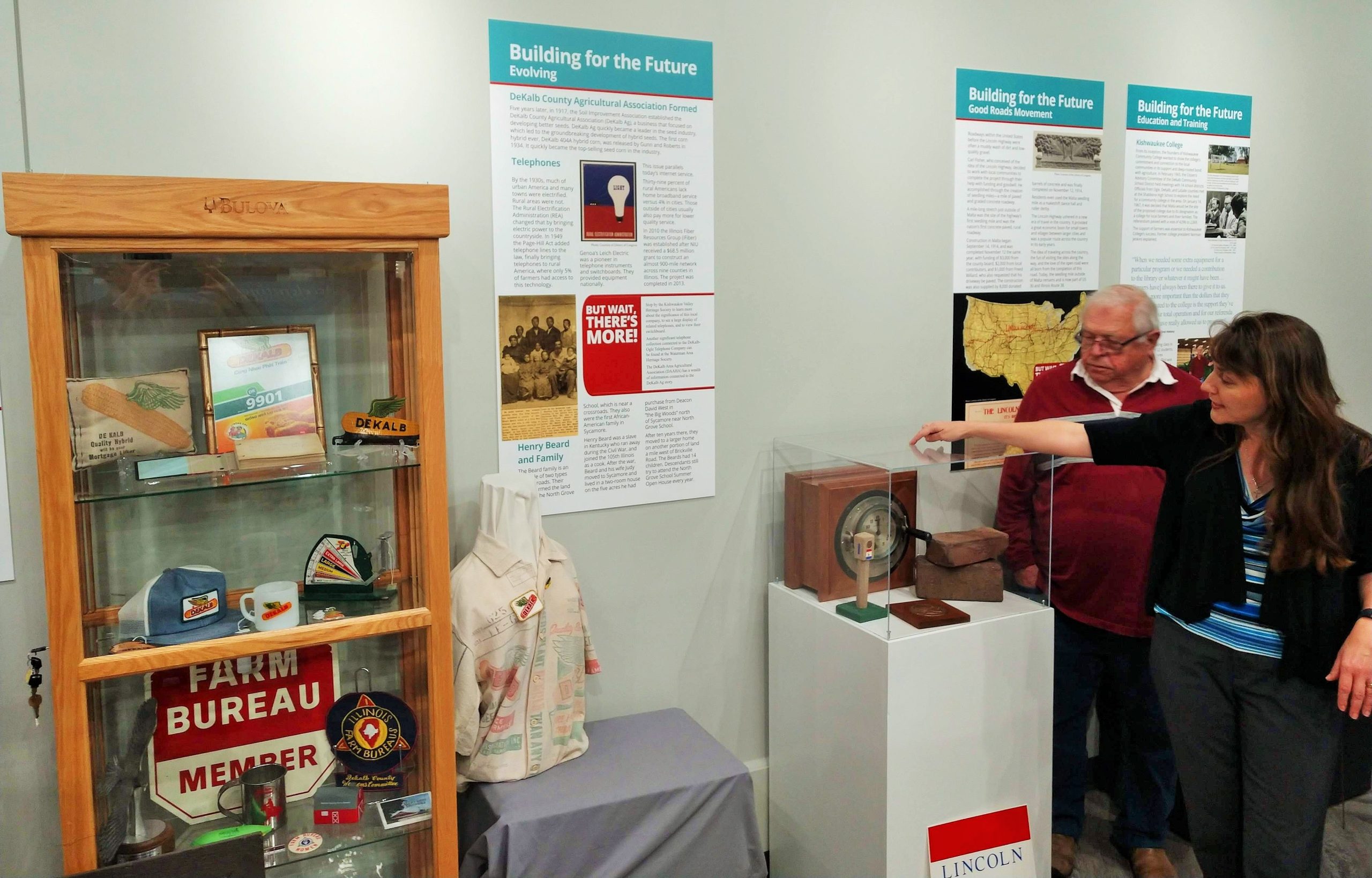Chapter 3: Fertile Ground for Agricultural Change, Part 1
Agriculture in all of its dimensions—environmental, economic, technological, social, and cultural—remains integral to rural Illinois in all of its dimensions. Changes in agriculture often intersect with changes in other facets of life in our state and have far-reaching implications, as many of the Crossroads: Change in Rural America host organizations’ companion exhibitions and programs illustrated.
The damming of the Kaskaskia River is just one of many factors in the significant evolution that agriculture in and around Shelby County has undergone in recent decades. The Lake Shelbyville Visitors Center’s companion exhibition noted that the estimated value of farmland in the county almost tripled between 2002 and 2018, increasing from $2,341 to $6,902 per acre. During the fifteen years from 2002 to 2017, the average yield per acre of corn in Shelby County grew from 111.9 to 198.6 bushels, and the soybean harvest increased from an average of 37.4 bushels per acre to 61 bushels per acre.

Technological advances that influenced agriculture not only regionally but nationally and globally have occurred in Shelby County, as viewers of the Visitors Center’s companion exhibition learned. Local farmer and inventor Horace Tallman purchased the Ann Arbor Machine Company and moved it from Michigan to Shelbyville in 1922. Within a few years, Tallman began developing plans for a pickup hay baler. The Ann Arbor Machine Company started marketing pickup balers in 1930, and by 1935, they were in use in at least twenty countries.[1]

The Oliver Farm Equipment Company purchased Ann Arbor in 1943 and continued manufacturing farm implements and tractors in Shelbyville. The White Motor Company of Cleveland, Ohio, purchased Oliver in 1960 and assumed operation of the Shelbyville factory. By 1963, the facility employed seven hundred people and produced a wide variety of farm machinery under several brand names associated with White, including Cockshutt and Minneapolis-Moline in addition to Oliver.[2]
That plant closed in 1970, but Shelbyville remains a center of implement production thanks to P & H Manufacturing, which has been in operation since 1951.[3] P & H initially specialized in applicators for anhydrous ammonia, a fertilizer widely used in row-crop farming, and other chemicals. The company still manufactures chemical applicators but also fabricates parts for heavy equipment, including cranes, as well as semitrailers and other vehicles.[4]

Additionally, the community retains an important place on the agricultural technology map because of the presence of Software Solutions Integrated, maker of Agvance software, which offers products intended to optimize and coordinate seemingly every aspect of farm management, from planting of crops to maintenance of vehicles to financial accounting. Agvance software is sold at more than 2,500 retail locations nationwide.[5]

Similarly, DeKalb County in northern Illinois has been a hub of nationally and internationally consequential agricultural innovation for more than a century and a half, as the DeKalb County History Center’s companion exhibition emphasized. (A version of that companion exhibition remains available for viewing online.) In the late 1850s, the Sandwich Manufacturing Company developed a practical portable corn sheller that quickly achieved widespread popularity and made the company a major local employer.[6] A decade later, the Marsh Harvester company moved to Sycamore. The company manufactured a harvester capable of cutting grain while operators stood on the harvester to bind it, reducing harvesting time, labor, and costs substantially by comparison with previous methods. The implement was sold throughout the United States and internationally, generating three hundred jobs locally.[7]


The variety of barbed wire that became standard nationally originated near DeKalb, patented in 1874 by prominent local farmer Joseph Glidden. Accounts vary as to what inspired Glidden’s invention. In one version of the story, while trying to devise an effective method of keeping livestock out of his wife’s vegetable garden, Glidden struck upon the idea of fashioning barbs from his wife’s hairpins and fastening them to wire fencing. He and a local blacksmith modified a coffee mill to twist the hairpins so that they could be coiled around a wire.[8]
Another rendition of the narrative claims that “in September of 1873, the DeKalb County Agricultural and Mechanical Society held a fair in DeKalb. There, Waterman resident Henry Rose showed a device he had just patented. Rose’s invention consisted of a thin wooden rail with nails driven into fence wire,” according to the text of the History Center’s exhibition. “One source relates that Glidden, seeing the fence, said out loud, ‘The barbs should be on the wire.’”[9]
The exhibition explained that three DeKalb countians—Glidden, hardware store owner and auctioneer Isaac Ellwood, and architect and contractor Jacob Haish—all viewed Rose’s invention, and each set about improving upon it. Ellwood developed his own version of barbed wire but recognized Glidden’s as superior and purchased an interest in Glidden’s patent. The two men formed a partnership and began manufacturing and distributing the product. Haish developed and patented additional varieties of barbed wire and subsequently disputed Glidden’s original claim. The case proceeded to the US Supreme Court, which ultimately ruled in Glidden’s favor. (Haish nevertheless achieved success as a manufacturer of engines.)[10]
According to the exhibition, more than three thousand designs of barbed wire were developed in the United States, including over four hundred that were distinctive enough to be patented. Of those, more than forty were developed in DeKalb County. The one patented by Glidden, known as “The Winner,” made land enclosure affordable for countless farmers and ranchers throughout the United States and beyond, especially in the American West. “As a new device, the adoption of barbed wire was faster than the adoption of the telephone,” the exhibition noted.[11]

As profoundly influential as the invention of an effective type of barbed wire was, another development that occurred in DeKalb County in the next century would prove equally transformative, if not more so.
In 1912, several forward-thinking farmers and civic leaders established the DeKalb County Soil Improvement Association, which advocated implementation of agricultural practices reflecting current scientific knowledge. The organization, which later evolved into the DeKalb County Farm Bureau, founded the DeKalb County Agricultural Association to make high-quality seed available to local farmers.[12] Two employees of the association, Charles Gunn and Thomas Roberts, were the first people to grow hybrid corn on a large scale and market the seed widely. (Several varieties of hybrid corn had been developed in various places in the preceding years, but none had been grown on a scale that made hybrid seed widely available and affordable.) Gunn and Roberts assertively promoted the variety that they developed in 1934, DeKalb 404A, among farmers throughout the Midwest. It soon became the top-selling seed in the Corn Belt.[13]
The association, subsequently called DeKalb Ag, emerged as one of the foremost producers of hybrid seed and other commercial agricultural supplies in the United States, offering resources for growers of sorghum, soybeans, cotton, hay crops, and chickens, in addition to corn. Known by its distinctive “winged ear of corn” logo, DeKalb maintained its national and international prominence throughout the twentieth century and was acquired by Monsanto in 1998.[14]

The DeKalb County History Center supplemented its examination of the technological facets of agriculture with exploration of the vocation’s social dimensions, presenting programs about local centennial and sesquicentennial farms. The events, which took place in four different locations throughout the county, were well attended and meaningful to the participants and the audiences. Representatives of the families associated with those farms shared experience-based insights and stories illustrating both continuity and change.
Michelle Donahoe, executive director of the center, noted that a consistent theme across their presentations was that farms are great places to raise families and instill constructive values in young people: “Many of them said, ‘We taught our children the value of hard work and helping people out.’”[15]
Nevertheless, many of the participants—even those whose families have not only owned their farms but lived and worked on them for many decades—seemed uncertain as to whether that tradition would continue beyond the current generation. “The future is not assumed. Today, people are not saying, ‘Well, of course, we have a family farm; this is what you’re going to do,’” Donahoe commented.[16]

- Companion exhibition accompanying Crossroads: Change in Rural America, Lake Shelbyville Visitors Center, Shelbyville, IL, December 15, 2018-January 26, 2019; Sherry Schaefer and Jeff Hackett, Classic Oliver Tractors: History, Models, Variations & Specifications (Minneapolis: Voyageur Press, 2009), 16. ↵
- Companion exhibition, Lake Shelbyville Visitors Center; Schaefer and Hackett, Classic Oliver Tractors, 16-125. ↵
- Companion exhibition, Lake Shelbyville Visitors Center. ↵
- Companion exhibition, Lake Shelbyville Visitors Center; “Company History,” P & H Manufacturing (website), http://www.phmfg.com/history/index.html, accessed March 25, 2023. ↵
- “About Us,” Software Solutions Integrated (website), https://web.archive.org/web/20220523183049/https://www.agvance.net/company, accessed March 25, 2023; Companion exhibition, Lake Shelbyville Visitors Center, 2018-19. ↵
- “Building for the Future,” section of a companion exhibition accompanying Crossroads: Change in Rural America, DeKalb County History Center, May 11-June 22, 2019, content from which is available at https://dchcexhibits.org/crossroads/building-for-the-future/. ↵
- “Building for the Future,” companion exhibition section, DeKalb County History Center. ↵
- “Barbed Wire: The Saga,” Joseph F. Glidden Homestead and Historical Center (website), http://www.gliddenhomestead.org/barbedwire.html, accessed March 25, 2023; “I.L. Ellwood & Barbed Wire,” Ellwood House Museum (website), http://www.ellwoodhouse.org/about-il-ellwood, accessed March 25, 2023. ↵
- “The Land,” section of a companion exhibition accompanying Crossroads: Change in Rural America, DeKalb County History Center, May 11-June 22, 2019, content from which is available at https://dchcexhibits.org/crossroads/land/. ↵
- “The Land,” companion exhibition section, DeKalb County History Center. ↵
- “The Land,” companion exhibition section, DeKalb County History Center. ↵
- “Building for the Future,” companion exhibition section, DeKalb County History Center. ↵
- Gregory Scott Bennet, “American Hybrid Corn History: A Century of Yields,” (master’s thesis, Iowa State University, 2001); A. Richard Crabb, The Hybrid Corn-Makers (New Brunswick, NJ: Rutgers University Press, 1947); Deborah Fitzgerald, The Business of Breeding: Hybrid Corn in Illinois, 1890-1940 (Ithaca, NY: Cornell University Press, 1990). ↵
- “100 Years of Agricultural Innovation,” DeKalb Area Agricultural Heritage Association (website), https://www.daaha.org/100-years-of-dekalb-ag-innovation, accessed March 25, 2023; “DeKalb AgResearch Records, 1910-2011” (finding aid), Regional History Center, Northern Illinois University, https://archon.lib.niu.edu/index.php?p=collections/findingaid&id=190&q=&rootcontentid=50577, accessed March 25, 2023. ↵
- Michelle Donahoe, telephone interview with author, September 27, 2019. ↵
- Michelle Donahoe, telephone interview with author, September 27, 2019. ↵



